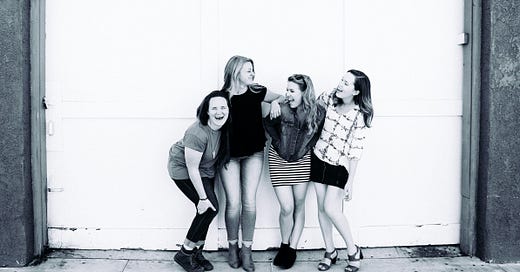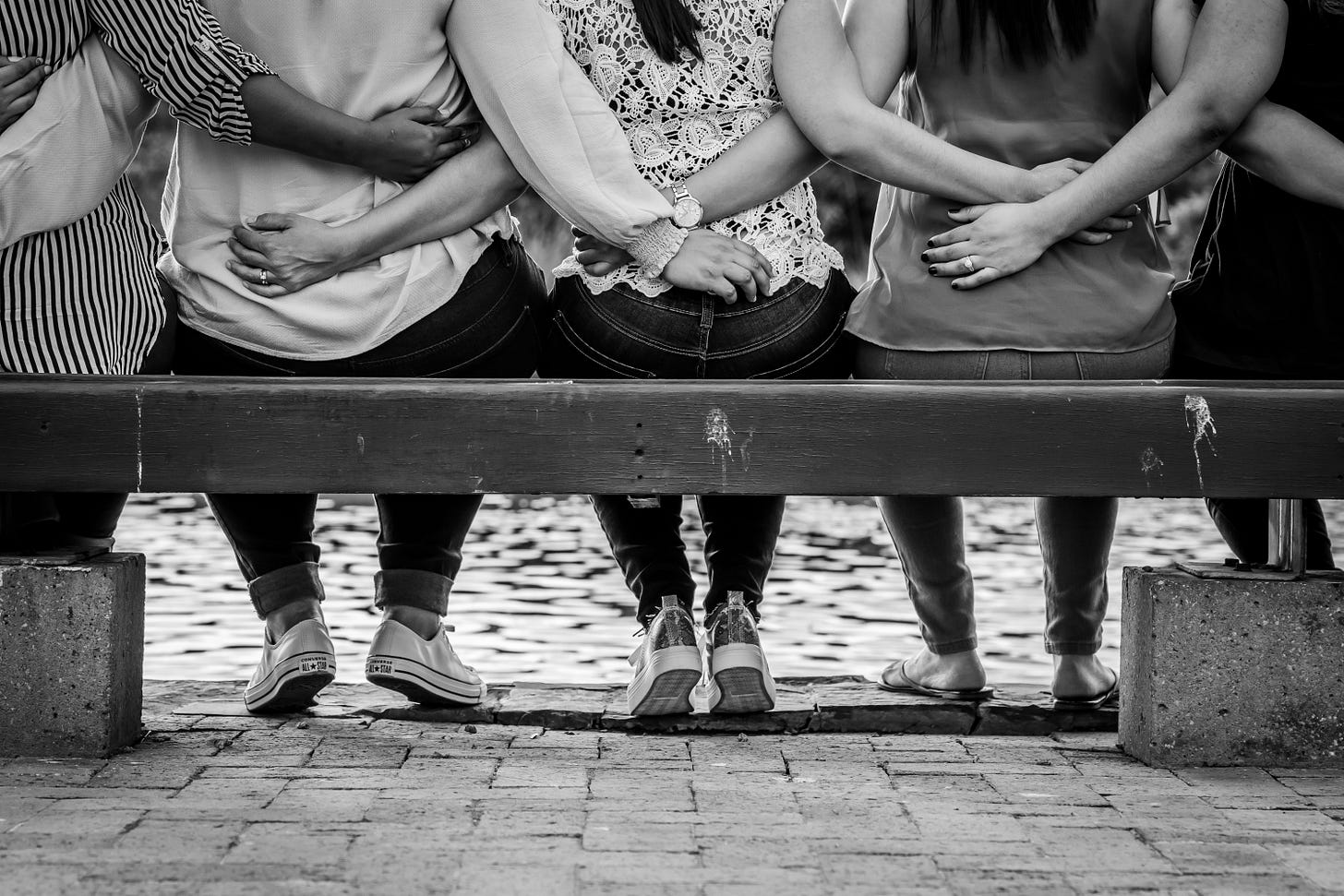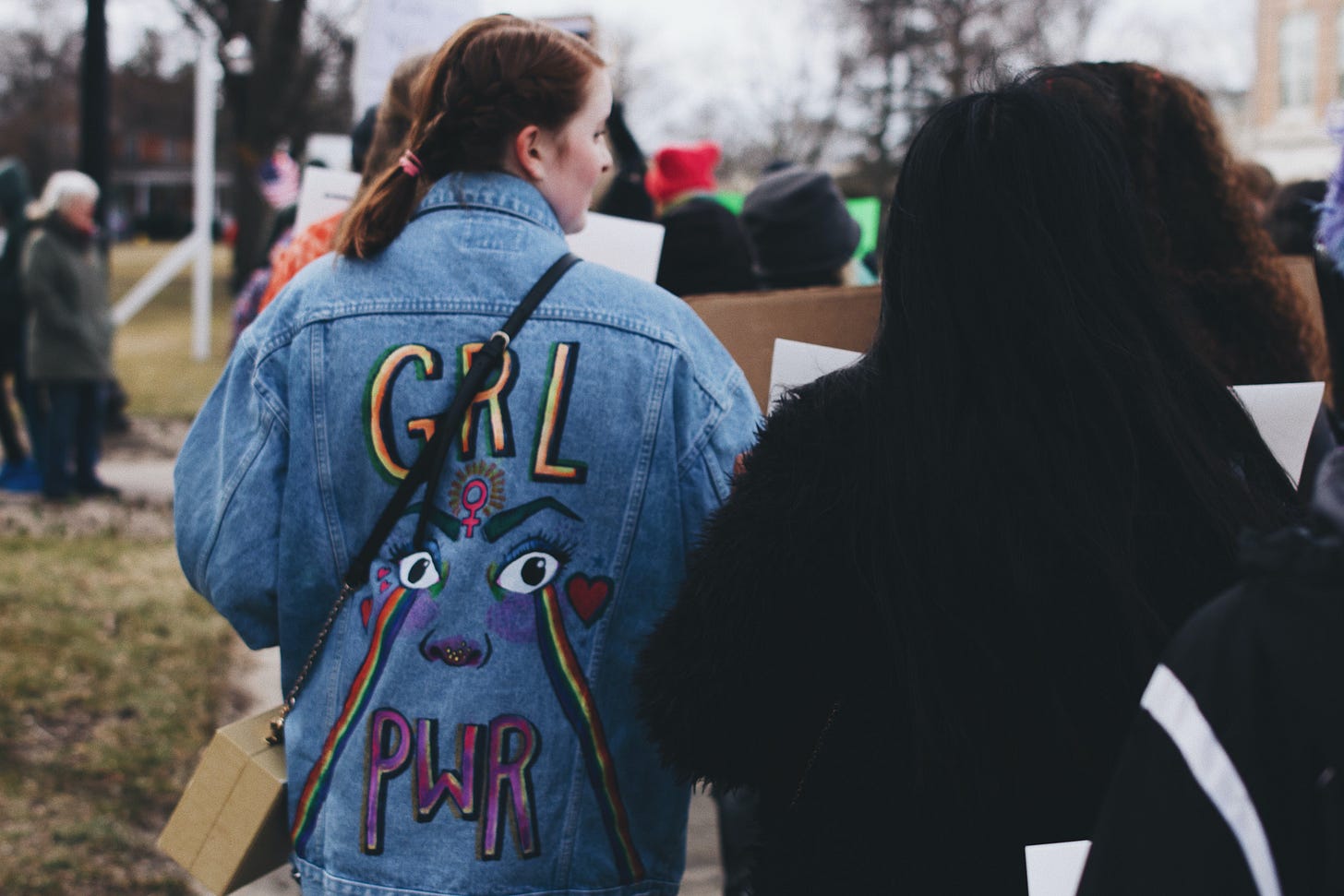Photo by Hannah Nelson
Following a recent visit to my local library, I was thinking about how many books I had read lately which featured contemporary women’s friendships.
In her non-fiction memoir Everything I Know About Love, which was recently released as a BBC series, writer, journalist and podcaster Dolly Alderton cleverly shows how her strongest and most faithful relationships have been with female friends. In the series, four female friends share a house when they move to London, ready to start their new lives as university graduates. The highs and lows of career ambitions, relationships, and partying are played out in a vibrant, contemporary story of twenty-something women’s lives.
It set me wondering about the literary women I admire, who are often represented as semi-recluses, hiding away and working on what were to become classics.
In their fascinating and engrossing book, A Secret Sisterhood: The Hidden Friendships of Austen, Brontë, Eliot and Woolf, authors Emily Midorikawa and Emma Claire Sweeney, both writer friends themselves, discuss the often neglected history of the friendships of literary women. Their in-depth research leads them to discover the close personal relationships all four of these women enjoyed, which they suggest helped to sustain them throughout their writing careers. They went on to discover that such female friendships were often left out or misconstrued in later biographies of the authors, whilst friendships between male writers is often celebrated.
One of the more well-known friendships of the modernist women’s era was between Katherine Mansfield and Virginia Woolf. However, the authors suggest that the relationship between these two successful modernist women writers is often misunderstood, with focus placed on the rivalry between the pair.
The meeting between Mansfield and Woolf was initiated by another of Woolf’s writer contemporaries within the Bloomsbury Group, Lytton Strachey, who had encountered Katherine Mansfield at a literary gathering whilst she was reading Woolf’s debut novel The Voyage Out. When Mansfield responded to Strachey that she would very much like to meet the novel’s author, he wrote to Woolf and the meeting was arranged.
Though already 35 years of age, Woolf had so far only published her first novel, whilst Mansfield, a native New Zealander, had a collection of short stories and many published magazine stories under her belt.
Woolf meanwhile determined to overcome outdated Victorian ideals of womanhood by starting her own publishing house following her and husband Leonard’s purchase of a small printing press. She had hopes that Mansfield would be the first author to submit to the newly formed Hogarth Press outside of her own work and that of Leonard’s. Mansfield was keen to accept and a professional relationship built on mutual admiration was born.
But more than the professional relationship of two writers, the women also formed a bond of friendship which they recorded in many letters between both themselves and Woolf’s letters to her sister, the artist Vanessa Bell.
Rivalry and gossip, however, caused rifts between the pair. As Midorikawa and Sweeney detail, the first of such appears to have come about by Woolf’s over-sharing of Mansfield’s confidences within the closed Bloomsbury set. A rift was further made by Woolf seemingly using an idea suggested in a letter by Mansfield, resulting in the publication of her short story Kew Gardens, and which Mansfield took personally.
Both women, however, realised that their affiliation was more important, and tried to overcome their differences, despite letters between the two revealing their tensions. Woolf meanwhile spent 15 months meticulously bringing Mansfield’s story Prelude to press, which received very little critical praise upon its first release.
Further hurt appeared to have been caused by Mansfield’s publication of the short story ‘Bliss’, in which the central character Pearl resembled Woolf in her mannerisms, and the story of a couple’s loving but non-desiring marriage mirrored Virginia and Leonard’s own.
Despite their various rifts and hurt feelings on both sides, the pair of friends, who initially shared a love of literary discussion, later found their conversations tended further towards the personal. The authors of A Secret Sisterhood posit that it is likely that both women were repressing their sexuality as Mansfield had reportedly had lesbian relationships in the past, and Woolf was yet to have her ‘Sapphic’ awakening with the aristocratic writer Vita Sackville-West.
Further complications could have ruptured the already fragile friendship when Mansfield and husband John Middleton Murry started their own small press, mirroring the Woolf’s. Insult added to injury when Mansfield wrote a fairly critical review of Woolf’s novel Night and Day, criticising it for its over-simplification of WW1. It appeared, through letters and journal entries, that Mansfield’s jealousy lie in what she perceived as Virginia’s success of a more stable and privileged life, enabling her to dedicate herself to her writing.
Despite all this, however, it appears that Woolf’s visits to Mansfield stimulated her creativity. Midorikawa and Sweeney claim that biographers have been reluctant to acknowledge the deep influence Mansfield, as a lesser-known writer, had on the pioneering female modernist that Woolf became.
Similarly, they point out that Murry’s publication of his wife’s journal entries and letters following her death omitted any reference to the Woolf’s or the friendship of the two women, indicating that his wife had relied on him alone for her literary companion.
It appears that because of the prevalent ideas of male writers and literary critics that only allowed for one woman at the top in literary terms at a time, and that women are naturally likely to be rivals for this imaginary top spot, the male literati fed the myth that Woolf and Mansfield were often bitter rivals.
I found this idea interesting. I have often heard women’s relationships referred to as being more complex than that of men. I’m not sure whether this comes down to the ideas inhabited within the patriarchal space that women must naturally be rivals - whether for male attention or career success. However, what the authors of A Secret Sisterhood discovered was the proliferation of such examples of writerly friendship and support within the women’s writing space. Their website Something Rhymed celebrates these friendships, with female writer/friends encouraged to submit posts to their blog.
Photo by Luwadlin Bosman on Unsplash
Dolly Alderton’s books of contemporary women’s friendships are not necessarily about finding writerly support, but they are interesting to consider as examples of the complexities of female friendships of the modern woman.
Everything I Know About Love challenges the idea of women as rivals, whether for men or career success. All of the housemates within the BBC series are supportive of one another’s career choices, celebrating and commiserating their successes and failures. The lead protagonist Maggie, who represents Dolly in the book, struggles to accept best friend Birdy’s new romance, which seems to be getting serious pretty quickly. However, it isn’t that Maggie wants what Birdy has for herself, and it certainly isn’t professional rivalry which comes between the two friends. In fact, Maggie is actually doing pretty well in her career and isn’t ready for a serious relationship. It is the continuing friendship with Birdy that she craves - the same one they have had since they were adolescents at school, crushing on boys and dreaming of living together some day in the big city.
Throughout Everything I Know About Love, Maggie and her other housemates continually make errors of judgement as they struggle through their early twenties. Interestingly though – and truthfully, it seems – their main struggles are with careers and their place in the world after the relatively safe cushioning of university.
As an example of the Bechdel test, the BBC series would pass with flying colours. Though relationships with men come up, they are not the focus of the story. The strength and resilience of female friendship reigns in these contemporary examples of how female friendship works. If men appear in the story, it is merely to show how the women’s interactions affect their overall wellbeing and their respective responses to one another.
Alderton’s book shows the multitudes of layers that are contained in female friendships. When Maggie hears her childhood friend Birdy telling her new couples’ friends’ that Maggie ‘is a bit of a nightmare’, the blow crushes her far more than her career going awry, or the hurt she feels at the casual relationship with Street, the musician she picks up in a local bar.
It raises the question: could it be that the complexities of female friendships have long been misunderstood because they have been largely written out of existence in the history books?
Women’s roles in the early part of the 20th century were often firmly fixed: daughter, wife, mother, and were seen as central to the functioning of the household. Friendships with other women could be seen as a threat to this agreeable status quo for the patriarchy. We only have to consider the successful rise of the Suffragette movement in the early part of the 20th century – where women came together to achieve women’s suffrage – to see what can happen when women mobilise en masse.
In more recent history, consider the nuclear disarmament movement which culminated in the Greenham Common camp in the UK in the 1980’s. I was just a child, yet still remember the passionate women speaking of the camp on the TV news, finding that though the conditions were often harsh, the camaraderie they found amongst other women and the friendships and bonds they made during that time stuck with them forever. Many did not return to their domestic situations following such an extreme experience with other women, perhaps alluding to the concerns male writers and critics may have experienced back in the earlier part of the century.
Photo by Brianna Tucker on Unsplash
All this to say that perhaps it is time to re-examine the stories we have been told about the conflicts and rivalries between women. When women come together to share their experiences and to work towards a common goal - whether that be changing political policy; or as writer friends, supporting one another through the trials and tribulations of getting their work published - it appears that it really can change the world.







I’m fascinated by friendships, especially between women, and have always felt that material (literary or film) is lacking on the subject. Thanks for sharing these references!